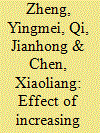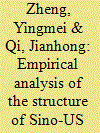|
|
|
Sort Order |
|
|
|
Items / Page
|
|
|
|
|
|
|
| Srl | Item |
| 1 |
ID:
104942


|
|
|
|
|
| Publication |
2011.
|
| Summary/Abstract |
Given China's heavy reliance on fuel energy and the dominance of its industrial sector in the economy, improving energy efficiency remains one of the practical means for the country to decrease energy intensity and to fulfill its commitment made at the Copenhagen Climate Change Conference to achieve a 40-45 percent reduction in CO2 emission intensity by 2020. This study investigates the impact of exports on industrial energy intensity to explore the possibility of reducing energy intensity through greater exports. A panel varying-coefficient regression model with a dataset of China's 20 industrial sub-sectors over 1999-2007 suggests that in general, greater exports aggravate energy intensity of the industrial sector and that great divergences exist in the impact of exports on energy intensity across sub-sectors. A panel threshold model further estimates the thresholds for the major determinants of energy intensity: exports, input in technological innovations, and Foreign Direct Investment (FDI) intensity. Given the great differences in specific sub-sector characteristics and the changing roles played by different factors across sub-sectors, there is no general export policy that would work for all sub-sectors in reducing sub-sector energy intensity. Instead, policies and measures aiming to encourage more efficient use of energy should take into full consideration the characteristics and situations of individual sub-sectors.
|
|
|
|
|
|
|
|
|
|
|
|
|
|
|
|
| 2 |
ID:
078278


|
|
|
|
|
| Publication |
2007.
|
| Summary/Abstract |
This paper empirically analyzes the structure of agricultural trade between China and the USA from 1996 to 2005, using different trade indexes such as the Grubel-Lloyd Index, the Revealed Comparative Advantage Index, the Finger-Kreinin Similitude Index and the Export Diversification Index, with a focus on the issues impeding Sino-US agricultural trade. We found that over the period of 1996 to 2005, inter-industry trade outweighed intra-industry trade in Sino-US agricultural trade, and that bilateral trade was more complementary than competitive. At the same time, China's agricultural exports were more diversified than USA exports, but China's degree of diversification steadily declined during the sample period. The findings indicate that there exists great potential for further development of agricultural trade between China and the USA, and that positive and effective trade policies will result in maximization of potential agricultural trade development and will bring forth mutual benefits to both countries
|
|
|
|
|
|
|
|
|
|
|
|
|
|
|
|
| 3 |
ID:
090107


|
|
|
|
|
| Publication |
2009.
|
| Summary/Abstract |
Economic theory posits numerous channels through which FDI might create positive spillovers for domestic firms. However, the results of empirical studies that have sought to document these spillovers have been mixed. One explanation for this variation is that the capacity of domestic firms to absorb spillovers might vary. In the present paper, we explore these issues in the case of China. Aside from being one of the world's leading hosts of foreign direct investment, China makes for an interesting case study because its provinces vary greatly with respect to those factors most commonly held to influence absorptive capacity, such as the initial level of technology in domestic firms. This paper begins by empirically establishing that the spillovers from foreign direct investment do indeed vary across provinces. Threshold values for various factors that influence absorptive capacity factors are then estimated and it is found that conditions in many provinces presently fall short of these values. This provides an obvious focus of attention for China's policy-makers.
|
|
|
|
|
|
|
|
|
|
|
|
|
|
|
|
|
|
|
|
|